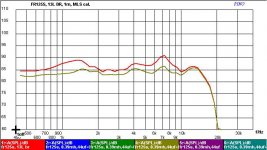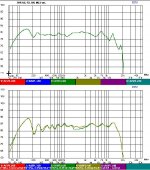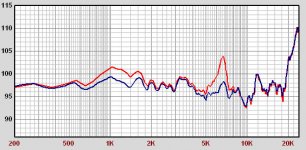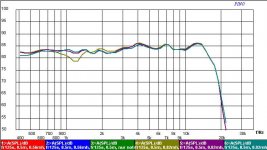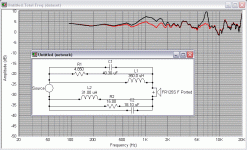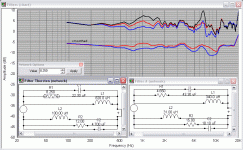Vikash said:This may be of interest. Also read Dan Wiggins' post further down in that thread.
Don't know how i missed that one... combined with his earlier post on voltage drive levels, would make a good little article
dave
Hi,
it's not because of the driver trust me! DIY magazines "Hobby Hifi" and "Klang + Ton" measured FR125S over 20kHz (up to 30kHz!!). It's just my microphone.
Measurements below 370Hz are quite "useless" at my place because it would only display room reflections.......
Regards
Thorsten
it's not because of the driver trust me! DIY magazines "Hobby Hifi" and "Klang + Ton" measured FR125S over 20kHz (up to 30kHz!!). It's just my microphone.
Measurements below 370Hz are quite "useless" at my place because it would only display room reflections.......
Regards
Thorsten
Sd. The VAS measurements, especially from the German mags, seem to be furher out then some of the others. I just noticed Thorsten's post above that lists the Sd used=50cm2 not 57cm2 from the datasheet.
Taking an example of one of my units with a measured VAS of 6.054 litres using Sd=57cm2, and recalculating with Sd=50cm2 results in VAS=4.658.
Thorsten, you could do nearfield measurements perhaps for below 370Hz?
Taking an example of one of my units with a measured VAS of 6.054 litres using Sd=57cm2, and recalculating with Sd=50cm2 results in VAS=4.658.
Thorsten, you could do nearfield measurements perhaps for below 370Hz?
Nearfield and new notch
Hi,
today I made a nearfield plot without notch. The 180Hz bump is possibly because of enclosure resonances due to a undamped back wall.
Below is a plot with a new notch filter. Reason:
We compard the box 1:1 with Jordan JX92s in Jordan TML. Although the frequency range with the inital notch filters war pretty flat we didn't like the upper midrange.
We tried some notch variants and ended with two:
Var.1: 0.47mH / 22uF / 12ohms (green line)
Var.2: 0.47mH / 33uF / 12ohms
We prefered Var.2 because the upper midrange was a bit softer.
Notch 2 (for 7000Hz dip) is still valid: 0.1mH / 4.7uF / 12ohms.
The curves might don't look good at all but they sounded great!
Regards
Thorsten
Hi,
today I made a nearfield plot without notch. The 180Hz bump is possibly because of enclosure resonances due to a undamped back wall.
Below is a plot with a new notch filter. Reason:
We compard the box 1:1 with Jordan JX92s in Jordan TML. Although the frequency range with the inital notch filters war pretty flat we didn't like the upper midrange.
We tried some notch variants and ended with two:
Var.1: 0.47mH / 22uF / 12ohms (green line)
Var.2: 0.47mH / 33uF / 12ohms
We prefered Var.2 because the upper midrange was a bit softer.
Notch 2 (for 7000Hz dip) is still valid: 0.1mH / 4.7uF / 12ohms.
The curves might don't look good at all but they sounded great!
Regards
Thorsten
Attachments
"Last notch version"
Hi,
we did some measuring & listening sessions (1:1 with Jordan JX92s TML) and came up with our final version:
Notch 1: 0.82 mH / 8.2 Ohm / 22 uF
Notch 2: 0.1 mH / 12 Ohm / 4.7 uF (unchanged)
The line with the dip is without the 8.2 ohms.
Regards
Thorsten
Hi,
we did some measuring & listening sessions (1:1 with Jordan JX92s TML) and came up with our final version:
Notch 1: 0.82 mH / 8.2 Ohm / 22 uF
Notch 2: 0.1 mH / 12 Ohm / 4.7 uF (unchanged)
The line with the dip is without the 8.2 ohms.
Regards
Thorsten
Attachments
Vikash said:Hi Thorsten,
Bare with me, I'm learning as I go along...but here's my measured FR and modelled response with two notch filters:
1k notch
C1: 170uf
L1: 90uH
R1: 1.2R
7k notch
C2: 30uf
L2: 19uH
R2: 5R
Any feedback appreciated.
Hi Vikash,
I find the values of the components in your notch filters quite strange.
The formular says, the peak frequency f=1/(2*pi*sqrt(L*C)) with L in Farad and C in Henry. A bigger L results in a lower f2 and smaller C results in a higher f1. The max. attenuation At is set by the resitor R (3dB ~ 4Ohm). I don't know any formular that would help finding the values for L and C with given f2 and f1, for me that's a matter of simulations and tryouts.
With this formular, in theory!, your 1k notch would target ~ 1300 Hz, which would be correct, but again, to me the values seam very strange for a notch filter, don't know what it would do really... actually I wouldn't know where to get a 0.09mH or 0.019mH air core inductor.
I have build Validators filters for my 12 liters BR cabinets and they seam to work pretty well. The 1k filter with L1=0.8mH also targets the bafflestep, in Valis case 18cm bafflewidth, i.e. in my case with a 24 cm baffle the L1 is around 1,2mH.
An externally hosted image should be here but it was not working when we last tested it.
best, lc
After several months testing this driver in actual use, I believe I have a break-in time (everyday listening at ~500mW avg power) for optimum and unchanging performance - 200 hours.
After the first 100, the mids really clear up and the treble >8KHz starts to climb.
My humble
After the first 100, the mids really clear up and the treble >8KHz starts to climb.
My humble

Hi Vikash, the 1k notch looks pretty much okay. 0.35mH, 39uF and 8.2Ohm was my starting point, it will flaten the peak. I don't know speaker workshop, but is it possible to change the value of the components and see what happens?Vikash said:I did some more playing this evening, this time using Speaker Workshop to simulate the two notch filters. Can you see what I'm doing wrong?
200+ hours? wow.Geek said:After several months testing this driver in actual use, I believe I have a break-in time (everyday listening at ~500mW avg power) for optimum and unchanging performance - 200 hours.
After the first 100, the mids really clear up and the treble >8KHz starts to climb.
Geek , I saw on your site that you have a BR design up and running with the FR125S, is it possible to see a messurement of the 200h+ broken in speaker? I mean it would be perfect when everything clears up without filters and the only thing needed is a BSC network!
best, LC
Hi lc, yes I have derived those component values by manually fine tuning and viewing the results in SW.
I've attached another simulations this time with Thorstens notch as well. I'm happy with the 1k notch as subtle differences here will be due to the differences between our cabinets.
I've come to the conclusion that the 0.1mH inductor is used for practicality rather than it being ideal (you're right, the smallest air core on madisound.com for example is 0.1mH). This might neccesitate a little unwinding if the rest of the values look ok.
Your opinion is appreciated as always.
I've attached another simulations this time with Thorstens notch as well. I'm happy with the 1k notch as subtle differences here will be due to the differences between our cabinets.
I've come to the conclusion that the 0.1mH inductor is used for practicality rather than it being ideal (you're right, the smallest air core on madisound.com for example is 0.1mH). This might neccesitate a little unwinding if the rest of the values look ok.
Your opinion is appreciated as always.
Attachments
lovechild said:Geek , I saw on your site that you have a BR design up and running with the FR125S, is it possible to see a messurement of the 200h+ broken in speaker?
When things get less insane here, sure!
Vikash said:Hi lc, yes I have derived those component values by manually fine tuning and viewing the results in SW.
I've attached another simulations this time with Thorstens notch as well. I'm happy with the 1k notch as subtle differences here will be due to the differences between our cabinets.
I've come to the conclusion that the 0.1mH inductor is used for practicality rather than it being ideal (you're right, the smallest air core on madisound.com for example is 0.1mH). This might neccesitate a little unwinding if the rest of the values look ok.
Your opinion is appreciated as always.
Is the original curve just one driver or are other drivers exactly the same?
- Status
- This old topic is closed. If you want to reopen this topic, contact a moderator using the "Report Post" button.
- Home
- Loudspeakers
- Full Range
- FR125S Measurements and Filters
